The two modes of plastic deformation are: 1. Slip, and 2. Twinning.
MECHANISM OF PLASTIC DEFORMATION (Modes of Plastic Deformation)
The two modes of plastic deformation are:
1. Slip, and 2. Twinning.
1. Deformation by Slip
✔ Slip may be defined as the sliding of blocks of the crystal over one another along definite crystallographic planes called slip planes.
✔ In other words, slip represents a displacement of one part of the crystal relative to another along particular crystallographic planes and in certain crystallographic directions. The particular crystallographic planes are called slip planes and the preferable direction is called the slip direction, as shown in Fig.5.1.
✔ There are one or more slip planes and one or more slip directions in each crystal.
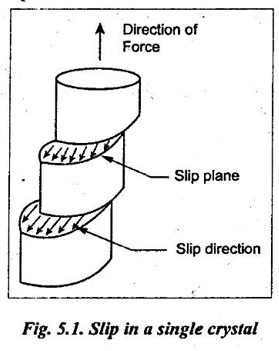
✔ The combination of a slip plane and slip direction is known as slip system. Fig.5.2 illustrates a slip system for FCC lattice.
✔ The concept of slip can be considered analogous to the distortion produced in a deck of cards when it is pushed from one end.
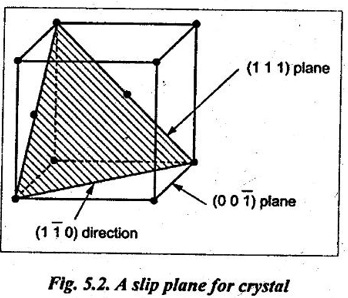
1. Mechanism of Slip
✔ The slip occurs by translatory motion along sliding planes and rotation of the specimen.
✔ Fig.5.3 illustrates the mechanism of slip.
✔ Fig.5.3 (a) depicts the layers of planes of an ideal crystal. Let us consider the shear stress acting on the crystal, as indicated by the arrows.
✔ When the shear stress exceeds the critical value, then the slip occurs, as shown in Fig.5.3 (b).
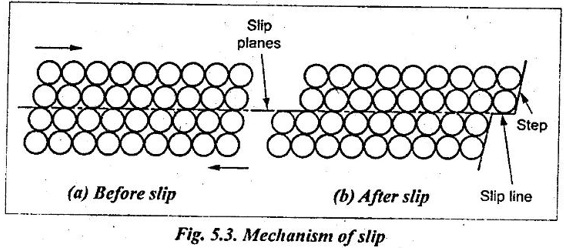
✔ It is experimentally proved that the mechanism of slip is actually due to the movement of dislocations in the crystal lattice.
✔ The energy of a dislocation line is given by the relation
E ∝ G.l.b2 …… (5.1)
where
G = Shear modulus,
l = Length of dislocation line, and
b = Unit slip vector, also known as Burger's vector.
✔ Thus it can be noted from the above relation that the dislocations having the shortest slip vector (b) are the easiest dislocations to generate and to expand for plastic deformation.
2. Critical Resolved Shear Stress for Slip
✔The extent of slip in a single crystal depends on the magnitude of the shearing stress produced by external loads, the geometry of the crystal structure, and the orientation of the active slip planes with respect to the shearing stresses.
✔ Slip begins when the shearing stress on the slip plane in the slip direction reaches a threshold value called the critical resolved shear stress.
Calculation of critical resolved shear stress
Consider a cylindrical single crystal subjected to an axial load as shown in Fig.5.4.
Let
P = Axial load applied along the crystal axis,
A = Area of cross-section of the crystal,
ϕ = Angle between the normal to the slip plane and the tensile axis, and
λ = Angle which the slip direction makes with the tensile axis.
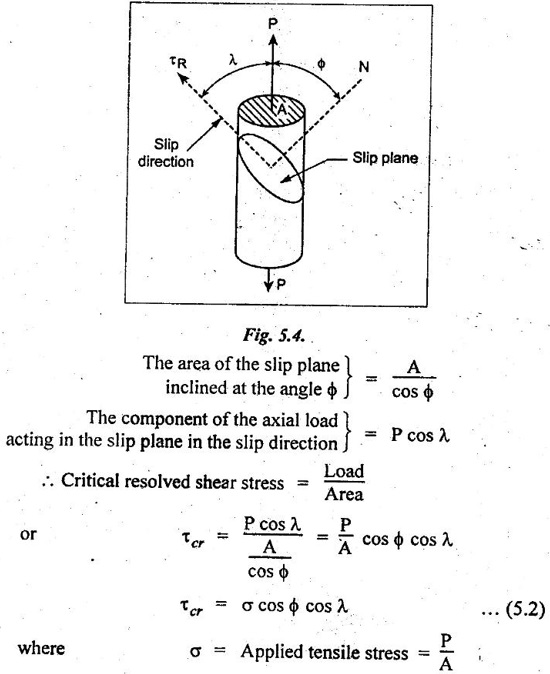
✓ The stress required at a given temperature to initiate slip in a pure and perfect single crystal, for a material is constant. This is known as Schmid's law.
✓ In equation (5.2), the term 'cos φ cos λ ' is known as the Schmid's factor.

Slip will not occur for these extreme orientations since there is no shear stress on the slip plane. Crystals close to these orientations tend to fracture rather than slip.
3. Deformation by Twinning
✔ The second important mechanism by which metals deform is the process known as twinning.
✔ Twinning is the process in which the atoms in a part of a crystal subjected to stress, rearrange themselves so that one part of the crystal becomes a mirror image of the other part.
✔ Like slip, twinning almost takes place in special planes called twinning planes.
✔ In most plastic deformation, twinning is relatively insignificant, but it may have considerable influence on the total amount of deformation.
✔ It should be noted that twinning differs from slip in that every plane of atoms suffers some movement, and the crystallographic orientations of many unit cells are altered.
1. Mechanism of Twinning
✔ Fig.5.5 illustrates the mechanism of twinning.
✔ Fig.5.5 (a) depicts the arrangement of atoms before twinning.
✔ Fig.5.5 (b) depicts the arrangement of atoms after twinning. In Fig.5.5 (b), the planes AB and CD are known as twining planes.
✔ The crystals twin about the twinning planes. The twinning occurs due to the growth and movement of dislocations in the crystal lattice.
✔ It can be noted from the Fig.5.5 (b) that the arrangement of atoms on either side of the twinning planes remain unaffected.
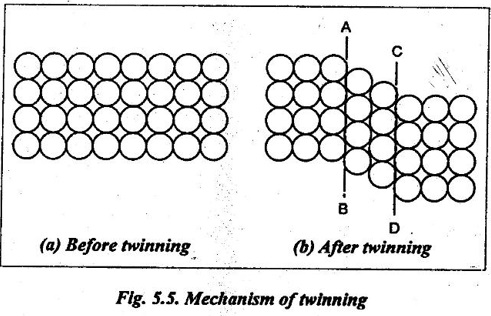
2. Types of Twins (Causes of Twins)
Two types of twins are:
1. Mechanical twins:
✔ Twins that are produced by mechanical deformation are called mechanical twins.
✔ Mechanical twins are produced in BCC or HCP metals, under the conditions of decreased temperature and shock loading.
2. Annealing twins:
✔ Twins that are produced by annealing are called annealing twins.
✔ Most of FCC metals form annealing twins.
4. Slip Vs Twinning
The differences between slip and twinning are presented in Table 5.5.
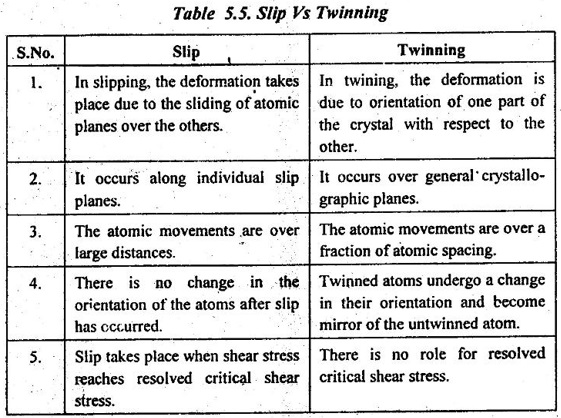
No comments:
Post a Comment